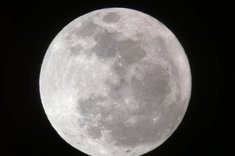Seeing the Super Blue Blood Moon on Wednesday (Jan. 31) may be easy for millions of people across the U.S. As long as the weather is clear , all you have to do is look up. But for astronauts on the International Space Station, weather doesn’t matter. In orbit, the biggest concerns for skywatching astronauts are being in the right place at the right time ― and having windows that face the right direction.
“Flight controllers did some analysis, and there is an opportunity for the astronauts to potentially see the lunar eclipse,” NASA spokesperson Dan Huot told Space.com in an email. Huot said that the space station will pass through Earth’s shadow one time during the eclipse, giving the Expedition 54 crew one opportunity to see the moon as Earth casts a reddish-brown shadow on its surface.
However, given the crew’s busy work schedules, they may not be able to make it to a moon-facing window in time to see the eclipse, Huot said. “[It’s] one thing to be in the area, [but that] doesn’t do you much good if the moon is somewhere in the sky where they don’t have a window,” Huot said. [How to Photograph a Total Lunar Eclipse: A Moon Photo Guide ]

0 of 10 questions complete
Flight controllers were able to locate a moon-facing window where the astronauts can watch the eclipse, but because the eclipse will be happening in the middle of the work day, “we can’t guarantee they’ll be able to break away to take photos,” Huot said.
If the crew does not get a chance to photograph the eclipse, at least one camera at the space station might still be pointed at the moon during the eclipse. Huot said that flight controllers are “going to look at possibly getting the moon on video using one of the external station cameras, but that depends on if there are any available video downlink channels.”
We’ll have to wait and see if the space station crew or the external camera will manage to catch a glimpse of the eclipsed moon. In the meantime, skywatchers on Earth can visit Space.com for live eclipse coverage and a webcast provided by Slooh.com beginning at 5:45 a.m. EST (1045 GMT).
Editor’s note: If you capture an amazing photo or video of the Jan. 31 total lunar eclipse and would like to share it with Space.com for a story or gallery, send images and comments to spacephotos@space.com.
Email Hanneke Weitering at hweitering@space.com or follow her @hannekescience . Follow us @Spacedotcom , Facebook and Google+ . Original article on Space.com .

Comments are closed.